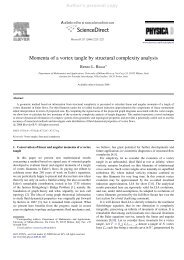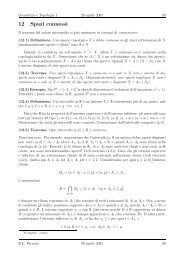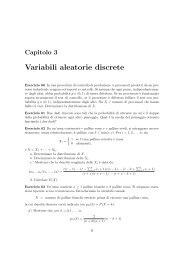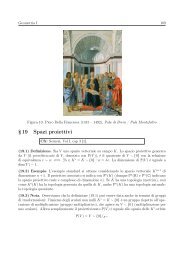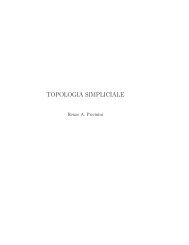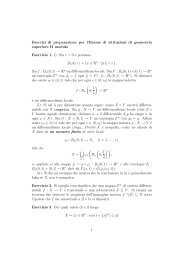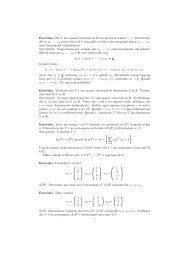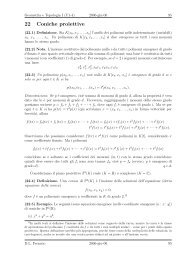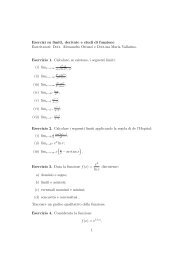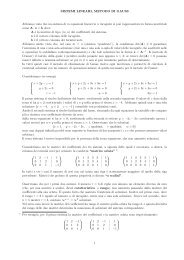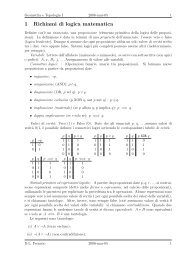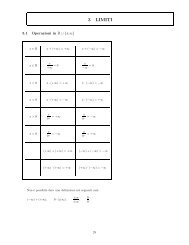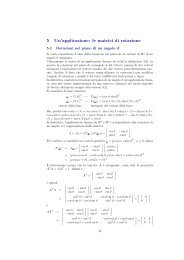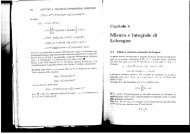Brjuno conditions for linearization in presence of resonances
Brjuno conditions for linearization in presence of resonances
Brjuno conditions for linearization in presence of resonances
You also want an ePaper? Increase the reach of your titles
YUMPU automatically turns print PDFs into web optimized ePapers that Google loves.
<strong>Brjuno</strong> <strong>conditions</strong> <strong>for</strong> <strong>l<strong>in</strong>earization</strong><br />
<strong>in</strong> <strong>presence</strong> <strong>of</strong> <strong>resonances</strong><br />
Jasm<strong>in</strong> Raissy<br />
Abstract. We present a new pro<strong>of</strong>, under a slightly different (and more natural)<br />
arithmetic hypothesis, and us<strong>in</strong>g direct computations via power series expansions,<br />
<strong>of</strong> a holomorphic <strong>l<strong>in</strong>earization</strong> result <strong>in</strong> <strong>presence</strong> <strong>of</strong> <strong>resonances</strong> orig<strong>in</strong>ally proved<br />
by Rüssmann.<br />
1 Introduction<br />
We consider a germ <strong>of</strong> biholomorphism f <strong>of</strong> C n at a fixed po<strong>in</strong>t p, which,<br />
up to translation, we may place at the orig<strong>in</strong> O. One <strong>of</strong> the ma<strong>in</strong> questions<br />
<strong>in</strong> the study <strong>of</strong> local holomorphic dynamics (see [1, 2, 4], or [11, Chapter<br />
1], <strong>for</strong> general surveys on this topic) is when f is holomorphically<br />
l<strong>in</strong>earizable, i.e., when there exists a local holomorphic change <strong>of</strong> coord<strong>in</strong>ates<br />
such that f is conjugated to its l<strong>in</strong>ear part .<br />
Away to solve such a problem is to first look <strong>for</strong> a <strong>for</strong>mal trans<strong>for</strong>mation<br />
ϕ solv<strong>in</strong>g<br />
f ◦ ϕ = ϕ ◦ ,<br />
i.e., toaskwhen f is <strong>for</strong>mally l<strong>in</strong>earizable, and then to check whether<br />
ϕ is convergent. Moreover, s<strong>in</strong>ce up to l<strong>in</strong>ear changes <strong>of</strong> the coord<strong>in</strong>ates<br />
we can always assume to be <strong>in</strong> Jordan normal <strong>for</strong>m, i.e.,<br />
⎛<br />
λ 1<br />
ε 2 λ 2<br />
= ⎜<br />
⎝<br />
. .. . ..<br />
ε n<br />
⎞<br />
⎟<br />
⎠ ,<br />
λ n<br />
where the eigenvalues λ 1 ,...,λ n ∈ C ∗ are not necessarily dist<strong>in</strong>cts, and<br />
ε j ∈{0,ε} can be non-zero only if λ j−1 = λ j ,wecan reduce ourselves<br />
to study such germs, and to search <strong>for</strong> ϕ tangent to the identity, that is,<br />
with l<strong>in</strong>ear part equal to the identity.
202 Jasm<strong>in</strong> Raissy<br />
The answer to this question depends on the set <strong>of</strong> eigenvalues <strong>of</strong> d f O ,<br />
usually called the spectrum <strong>of</strong> d f O .Infact, if we denote by λ 1 ,...,λ n ∈<br />
C ∗ the eigenvalues <strong>of</strong> d f O , then it may happen that there exists a multi<strong>in</strong>dex<br />
Q = (q 1 ,...,q n ) ∈ N n , with |Q| ≥2, such that<br />
λ Q − λ j := λ q 1<br />
1 ···λq n<br />
n − λ j = 0 (1.1)<br />
<strong>for</strong> some 1 ≤ j ≤ n; arelation <strong>of</strong> this k<strong>in</strong>d is called a (multiplicative)<br />
resonance <strong>of</strong> f relative to the j-th coord<strong>in</strong>ate, Q is called a resonant<br />
multi-<strong>in</strong>dex relative to the j-th coord<strong>in</strong>ate, and we put<br />
Res j (λ) := {Q ∈ N n ||Q| ≥2,λ Q = λ j }.<br />
The elements <strong>of</strong> Res(λ) := ⋃ n<br />
j=1 Res j(λ) are simply called resonant<br />
multi-<strong>in</strong>dices. A resonant monomial is a monomial z Q := z q 1<br />
1 ···zq n<br />
n <strong>in</strong><br />
the j-th coord<strong>in</strong>ate with Q ∈ Res j (λ).<br />
Resonances are the <strong>for</strong>mal obstruction to <strong>l<strong>in</strong>earization</strong>. Indeed, we<br />
have the follow<strong>in</strong>g classical result:<br />
Theorem 1.1 (Po<strong>in</strong>caré, 1893 [7]; Dulac, 1904 [6]). Let f be a germ <strong>of</strong><br />
biholomorphism <strong>of</strong> C n fix<strong>in</strong>g the orig<strong>in</strong> O with l<strong>in</strong>ear part <strong>in</strong> Jordan normal<br />
<strong>for</strong>m. Then there exists a <strong>for</strong>mal trans<strong>for</strong>mation ϕ <strong>of</strong> C n ,without constant<br />
term and tangent to the identity, conjugat<strong>in</strong>g f to a <strong>for</strong>mal power<br />
series g ∈ C[[z 1 ,...,z n ]] n without constant term, with same l<strong>in</strong>ear part<br />
and conta<strong>in</strong><strong>in</strong>g only resonant monomials. Moreover, the resonant part <strong>of</strong><br />
the <strong>for</strong>mal change <strong>of</strong> coord<strong>in</strong>ates ϕ can be chosen arbitrarily, but once<br />
this is done, ϕ and g are uniquely determ<strong>in</strong>ed. In particular, if the spectrum<br />
<strong>of</strong> d f O has no <strong>resonances</strong>, f is <strong>for</strong>mally l<strong>in</strong>earizable and the <strong>for</strong>mal<br />
<strong>l<strong>in</strong>earization</strong> is unique.<br />
A <strong>for</strong>mal trans<strong>for</strong>mation g <strong>of</strong> C n ,without constant term, and with l<strong>in</strong>ear<br />
part <strong>in</strong> Jordan normal <strong>for</strong>m with eigenvalues λ 1 ,...,λ n ∈ C ∗ ,is<br />
called <strong>in</strong> Po<strong>in</strong>caré-Dulac normal <strong>for</strong>m if it conta<strong>in</strong>s only resonant monomials<br />
with respect to λ 1 ,...,λ n .<br />
If f is a germ <strong>of</strong> biholomorphism <strong>of</strong> C n fix<strong>in</strong>g the orig<strong>in</strong>, a series<br />
g <strong>in</strong> Po<strong>in</strong>caré-Dulac normal <strong>for</strong>m <strong>for</strong>mally conjugated to f is called a<br />
Po<strong>in</strong>caré-Dulac (<strong>for</strong>mal) normal <strong>for</strong>m <strong>of</strong> f .<br />
The problem with Po<strong>in</strong>caré-Dulac normal <strong>for</strong>ms is that, usually, they<br />
are not unique. In particular, one may wonder whether it could be possible<br />
to have such a normal <strong>for</strong>m <strong>in</strong>clud<strong>in</strong>g f<strong>in</strong>itely many resonant monomials<br />
only. This is <strong>in</strong>deed the case (see, e.g., Reich [12]) when d f O belongs<br />
to the so-called Po<strong>in</strong>caré doma<strong>in</strong>, that is when d f O is <strong>in</strong>vertible and O is<br />
either attract<strong>in</strong>g, i.e., all the eigenvalues <strong>of</strong> d f O have modulus less than 1,
203 <strong>Brjuno</strong> <strong>conditions</strong> <strong>for</strong> <strong>l<strong>in</strong>earization</strong> <strong>in</strong> <strong>presence</strong> <strong>of</strong> <strong>resonances</strong><br />
or repell<strong>in</strong>g, i.e., all the eigenvalues <strong>of</strong> d f O have modulus greater than 1<br />
(when d f O is still <strong>in</strong>vertible but does not belong to the Po<strong>in</strong>caré doma<strong>in</strong>,<br />
we shall say that it belongs to the Siegel doma<strong>in</strong>).<br />
Even without <strong>resonances</strong>, the holomorphic <strong>l<strong>in</strong>earization</strong> is not guaranteed.<br />
The best positive result is essentially due to <strong>Brjuno</strong> [5]. To describe<br />
such a result, let us <strong>in</strong>troduce the follow<strong>in</strong>g def<strong>in</strong>itions:<br />
Def<strong>in</strong>ition 1.2. For λ 1 ,...,λ n ∈ C and m ≥ 2 set<br />
ω λ1 ,...,λ n<br />
(m) =<br />
ν≥0<br />
m<strong>in</strong><br />
2≤|Q|≤m<br />
1≤ j≤n<br />
|λ Q − λ j |. (1.2)<br />
If λ 1 ,...,λ n are the eigenvalues <strong>of</strong> d f O , we shall write ω f (m) <strong>for</strong><br />
ω λ1 ,...,λ n<br />
(m).<br />
It is clear that ω f (m) ̸= 0 <strong>for</strong> all m ≥ 2ifand only if there are no<br />
<strong>resonances</strong>. It is also not difficult to prove that if f belongs to the Siegel<br />
doma<strong>in</strong> then<br />
lim ω f (m) = 0,<br />
m→+∞<br />
which is the reason why, even without <strong>resonances</strong>, the <strong>for</strong>mal <strong>l<strong>in</strong>earization</strong><br />
might be divergent.<br />
Def<strong>in</strong>ition 1.3. Let n ≥ 2 and let λ 1 ,...,λ n ∈ C ∗ be not necessarily<br />
dist<strong>in</strong>ct. We say that λ satisfies the <strong>Brjuno</strong> condition if there exists a<br />
strictly <strong>in</strong>creas<strong>in</strong>g sequence <strong>of</strong> <strong>in</strong>tegers {p ν } ν≥ 0 with p 0 = 1 such that<br />
∑ 1 1<br />
log<br />
< ∞. (1.3)<br />
p ν ω λ1 ,...,λ n<br />
(p ν+1 )<br />
<strong>Brjuno</strong>’s argument <strong>for</strong> vector fields, when adapted to the case <strong>of</strong> germs<br />
<strong>of</strong> biholomorphisms, yields the follow<strong>in</strong>g result (see [8]).<br />
Theorem 1.4 (<strong>Brjuno</strong>, 1971 [5]). Let f be a germ <strong>of</strong> biholomorphism<br />
<strong>of</strong> C n fix<strong>in</strong>g the orig<strong>in</strong>, such that d f O is diagonalizable. Assume moreover<br />
that the spectrum <strong>of</strong> d f O has no <strong>resonances</strong> and satisfies the <strong>Brjuno</strong><br />
condition. Then f is holomorphically l<strong>in</strong>earizable.<br />
In the resonant case, one can still f<strong>in</strong>d <strong>for</strong>mally l<strong>in</strong>earizable germs, (see<br />
<strong>for</strong> example [9] and [10]), so two natural questions arise.<br />
(Q1) How many Po<strong>in</strong>caré-Dulac <strong>for</strong>mal normal <strong>for</strong>ms does a <strong>for</strong>mally<br />
l<strong>in</strong>earizable germ have?<br />
(Q2) Is it possible to f<strong>in</strong>d arithmetic <strong>conditions</strong> on the eigenvalues <strong>of</strong> the<br />
spectrum <strong>of</strong> d f O ensur<strong>in</strong>g holomorphic l<strong>in</strong>earizability <strong>of</strong> <strong>for</strong>mally<br />
l<strong>in</strong>earizable germs?
204 Jasm<strong>in</strong> Raissy<br />
Rüssmann gave answers to both questions <strong>in</strong> [13], an I.H.E.S. prepr<strong>in</strong>t<br />
which is no longer available, and that was f<strong>in</strong>ally published <strong>in</strong> [14]. The<br />
answer to the first question is the follow<strong>in</strong>g (the statement is slightly different<br />
from the orig<strong>in</strong>al one presented <strong>in</strong> [14] but perfectly equivalent):<br />
Theorem 1.5 (Rüssmann, 2002 [14]). Let f be a germ <strong>of</strong> biholomorphism<br />
<strong>of</strong> C n fix<strong>in</strong>g the orig<strong>in</strong>. If f is <strong>for</strong>mally l<strong>in</strong>earizable, then the l<strong>in</strong>ear<br />
<strong>for</strong>m is its unique Po<strong>in</strong>caré-Dulac normal <strong>for</strong>m.<br />
To answer to the second question, Rüssmann <strong>in</strong>troduced the follow<strong>in</strong>g<br />
condition, that we shall call Rüssmann condition.<br />
Def<strong>in</strong>ition 1.6. Let n ≥ 2 and let λ 1 ,...,λ n ∈ C ∗ be not necessarily<br />
dist<strong>in</strong>ct. We say that λ = (λ 1 ,...,λ n ) satisfies the Rüssmann condition<br />
if there exists a function : N → R such that:<br />
(i) k ≤ (k) ≤ (k + 1) <strong>for</strong> all k ∈ N;<br />
(ii) ∑ k≥1 1 log (k)
205 <strong>Brjuno</strong> <strong>conditions</strong> <strong>for</strong> <strong>l<strong>in</strong>earization</strong> <strong>in</strong> <strong>presence</strong> <strong>of</strong> <strong>resonances</strong><br />
Def<strong>in</strong>ition 1.8. Let n ≥ 2 and let λ 1 ,...,λ n<br />
dist<strong>in</strong>ct. For m ≥ 2set<br />
∈ C ∗ be not necessarily<br />
˜ω λ1 ,...,λ n<br />
(m) =<br />
m<strong>in</strong><br />
2≤|Q|≤m<br />
Q̸∈Res j (λ)<br />
m<strong>in</strong><br />
1≤ j≤n |λQ − λ j |,<br />
where Res j (λ) is the set <strong>of</strong> multi-<strong>in</strong>dices Q ∈ N n , with |Q| ≥2, giv<strong>in</strong>g a<br />
resonance relation <strong>for</strong> λ = (λ 1 ,...,λ n ) relative to 1 ≤ j ≤ n, i.e., λ Q −<br />
λ j = 0. If λ 1 ,...,λ n are the eigenvalues <strong>of</strong> d f O ,weshall write ˜ω f (m)<br />
<strong>for</strong> ˜ω λ1 ,...,λ n<br />
(m).<br />
Def<strong>in</strong>ition 1.9. Let n ≥ 2 and let λ = (λ 1 ,...,λ n ) ∈ (C ∗ ) n . We say<br />
that λ satisfies the reduced <strong>Brjuno</strong> condition if there exists a strictly <strong>in</strong>creas<strong>in</strong>g<br />
sequence <strong>of</strong> <strong>in</strong>tegers {p ν } ν≥ 0 with p 0 = 1such that<br />
We shall then prove:<br />
∑<br />
ν≥0<br />
1 1<br />
log<br />
p ν ˜ω λ1 ,...,λ n<br />
(p ν+1 ) < ∞.<br />
Theorem 1.10. Let f be a germ <strong>of</strong> biholomorphism <strong>of</strong> C n fix<strong>in</strong>g the orig<strong>in</strong><br />
and such that d f O is diagonalizable. If f is <strong>for</strong>mally l<strong>in</strong>earizable<br />
and the spectrum <strong>of</strong> d f O satisfies the reduced <strong>Brjuno</strong> condition, then f<br />
is holomorphically l<strong>in</strong>earizable.<br />
We shall also show that Rüssmann condition implies the reduced <strong>Brjuno</strong><br />
condition and so our result implies Theorem 1.7. The converse is<br />
known to be true <strong>in</strong> dimension 1, as proved by Rüssmann <strong>in</strong> [14], but is<br />
not known <strong>in</strong> higher dimension.<br />
The structure <strong>of</strong> this paper is as follows. In the next section we shall<br />
discuss properties <strong>of</strong> <strong>for</strong>mally l<strong>in</strong>earizable germs, and we shall give our<br />
direct pro<strong>of</strong> <strong>of</strong> Theorem 1.5. In Section 3 we shall prove Theorem 1.10<br />
us<strong>in</strong>g majorant series. In the last section we shall discuss relations between<br />
Rüssmann condition and the reduced <strong>Brjuno</strong> condition.<br />
ACKNOWLEDGEMENTS. Iwould like to thank Marco Abate <strong>for</strong> helpful<br />
comments on a draft <strong>of</strong> this work.<br />
2 Formally l<strong>in</strong>earizable germs<br />
In general, a germ f can have several Po<strong>in</strong>caré-Dulac <strong>for</strong>mal normal<br />
<strong>for</strong>ms; however, we can say someth<strong>in</strong>g on the shape <strong>of</strong> the <strong>for</strong>mal conjugations<br />
between them. We have <strong>in</strong> fact the follow<strong>in</strong>g result.
206 Jasm<strong>in</strong> Raissy<br />
Proposition 2.1. Let f and g be two germs <strong>of</strong> biholomorphism <strong>of</strong> C n<br />
fix<strong>in</strong>g the orig<strong>in</strong>, with the same l<strong>in</strong>ear part and <strong>in</strong> Po<strong>in</strong>caré-Dulac<br />
normal <strong>for</strong>m. If there exists a <strong>for</strong>mal trans<strong>for</strong>mation ϕ <strong>of</strong> C n ,with no<br />
constant term and tangent to the identity, conjugat<strong>in</strong>g f and g, then ϕ<br />
conta<strong>in</strong>s only monomials that are resonant with respect to the eigenvalues<br />
<strong>of</strong> .<br />
Pro<strong>of</strong>. S<strong>in</strong>ce f and g are <strong>in</strong> Po<strong>in</strong>caré-Dulac normal <strong>for</strong>m, is <strong>in</strong> Jordan<br />
normal <strong>for</strong>m. Let λ 1 ,...,λ n be the eigenvalues <strong>of</strong> . Weshall prove that<br />
a<strong>for</strong>mal solution ϕ = I + ̂ϕ <strong>of</strong><br />
f ◦ ϕ = ϕ ◦ g (2.1)<br />
conta<strong>in</strong>s only monomials that are resonant with respect to λ 1 ,...,λ n .<br />
Us<strong>in</strong>g the standard multi-<strong>in</strong>dex notation, <strong>for</strong> each j ∈{1,...,n} we can<br />
write<br />
∑<br />
f j (z) = λ j z j + ε j z j−1 + z j f j<br />
res (z) = λ j z j + ε j z j−1 + z j<br />
Q∈N j<br />
λ Q =1<br />
f Q, j z Q ,<br />
∑<br />
g j (z) = λ j z j + ε j z j−1 + z j g res<br />
j (z) = λ j z j + ε j z j−1 + z j g Q, j z Q ,<br />
Q∈N j<br />
λ Q =1<br />
and<br />
(<br />
ϕ j (z)= z j<br />
where<br />
1+ϕ res<br />
j (z)+ ϕ̸=res<br />
j<br />
∑<br />
∑<br />
(z)<br />
)= z j + z j ϕ Q, j z Q + z j ϕ Q, j z Q ,<br />
Q∈N j<br />
λ Q =1<br />
Q∈N j<br />
λ Q̸=1<br />
N j := {Q ∈ Z n ||Q| ≥1, q j ≥−1, q h ≥ 0 <strong>for</strong> all h ̸= j},<br />
and ε j ∈{0, 1} can be non-zero only if λ j = λ j−1 .With these notations,<br />
the left-hand side <strong>of</strong> the j-th coord<strong>in</strong>ate <strong>of</strong> (2.1) becomes<br />
( f ◦ϕ) j (z)<br />
=λ j ϕ j (z)+ε j ϕ j−1 (z)+ϕ j (z) ∑ n∏<br />
f Q, j ϕ k (z) q k<br />
Q∈N j k=1<br />
λ Q =1<br />
(<br />
=λ j z j 1+ϕ<br />
res<br />
j (z) ) (<br />
+ε j z j−1 1+ϕ<br />
res<br />
+z j<br />
(<br />
1+ϕ<br />
res<br />
j<br />
(z)+ϕ̸=res<br />
j<br />
(z)+ϕ̸=res<br />
j<br />
j−1 (z)+ϕ̸=res<br />
(z) ) ∑<br />
n∏ (<br />
f Q, j z Q 1+ϕ<br />
res<br />
k<br />
Q∈N j k=1<br />
λ Q =λ j<br />
j−1 (z))<br />
(z)+ϕ̸=res<br />
k<br />
(z) ) q k<br />
,<br />
(2.2)
207 <strong>Brjuno</strong> <strong>conditions</strong> <strong>for</strong> <strong>l<strong>in</strong>earization</strong> <strong>in</strong> <strong>presence</strong> <strong>of</strong> <strong>resonances</strong><br />
while the j-th coord<strong>in</strong>ate <strong>of</strong> the right-hand side <strong>of</strong> (2.1) becomes<br />
(ϕ◦g) j (z)<br />
= g j (z)+g j (z) ∑ Q∈N j<br />
λ Q =1<br />
ϕ Q, j<br />
n∏<br />
= λ j z j + ε j z j−1 + z j g res<br />
j (z)<br />
+ ( λ j z j +ε j z j−1 +z j g res<br />
j<br />
+ ( λ j z j +ε j z j−1 +z j g res<br />
j<br />
k=1g k (z) q k<br />
+g j (z) ∑ Q∈N j<br />
λ Q̸=1<br />
(z) ) ∑ n∏<br />
(<br />
ϕ Q, j z Q<br />
Q∈N j<br />
λ Q =1<br />
Q∈N j<br />
λ Q̸=1<br />
k=1<br />
(z) ) ∑ n∏<br />
(<br />
ϕ Q, j z Q<br />
k=1<br />
ϕ Q, j<br />
k=1<br />
n∏<br />
g k (z) q k<br />
λ k +ε k<br />
z k−1<br />
z k<br />
) qk<br />
+gk<br />
res (z)<br />
z k−1<br />
λ k +ε k +g res<br />
z k<br />
k (z) ) qḳ<br />
(2.3)<br />
Furthermore, notice that if P and Q are two multi-<strong>in</strong>dices such that λ P =<br />
λ Q = 1, then we have λ α P+β Q = 1<strong>for</strong>every α, β ∈ Z.<br />
We want to prove that ϕ Q, j = 0<strong>for</strong> each multi-<strong>in</strong>dex Q ∈ N j such<br />
that λ Q ̸= 1. Let us assume by contradiction that this is not true, and<br />
let ˜Q be the first (with respect to the lexicographic order) multi-<strong>in</strong>dex <strong>in</strong><br />
N := ⋃ n<br />
j=1 N j so that λ ˜Q ̸= 1 and ϕ ˜Q, j ̸= 0. Let j be the m<strong>in</strong>imal<br />
<strong>in</strong> {1,...,n} such that ˜Q ∈ N j ,and let us compute the coefficient <strong>of</strong> the<br />
monomial z ˜Q+e j<br />
<strong>in</strong> (2.2) and (2.3). In (2.2) we only have λ j ϕ ˜Q, j because,<br />
s<strong>in</strong>ce f − is <strong>of</strong> second order and resonant, other contributions could<br />
come only from coefficients ϕ P,k with |P| < | ˜Q| and λ P ̸= 1, but there<br />
are no such coefficients thanks to the m<strong>in</strong>imality <strong>of</strong> ˜Q and j. In(2.3) we<br />
can argue analogously, but we have also to take care <strong>of</strong> the monomials<br />
divisible by εk h (z k−1/z k ) h z P , with λ P = 1; <strong>in</strong> this last case, if ε k ̸= 0,<br />
we obta<strong>in</strong> a multi-<strong>in</strong>dex P − he k + he k−1 , and aga<strong>in</strong> λ P−he k+he k−1<br />
= 1<br />
because λ k = λ k−1 . Then <strong>in</strong> (2.3) we only have λ ˜Q+e j<br />
ϕ ˜Q, j. Hence, we<br />
have<br />
(λ ˜Q+e j<br />
− λ j )ϕ ˜Q, j = 0,<br />
yield<strong>in</strong>g<br />
ϕ ˜Q, j = 0,<br />
because λ ˜Q ̸= 1 and λ j ̸= 0, and contradict<strong>in</strong>g the hypothesis.<br />
Remark 2.2. It is clear from the pro<strong>of</strong> that Proposition 2.1 holds also <strong>in</strong><br />
the <strong>for</strong>mal category, i.e., <strong>for</strong> f, g ∈ C O [[z 1 ,...,z n ]] <strong>for</strong>mal power series<br />
without constant terms <strong>in</strong> Po<strong>in</strong>caré-Dulac normal <strong>for</strong>m.
208 Jasm<strong>in</strong> Raissy<br />
We can now give a direct pro<strong>of</strong> <strong>of</strong> Theorem 1.5, i.e., that when a germ<br />
is <strong>for</strong>mally l<strong>in</strong>earizable, then the l<strong>in</strong>ear <strong>for</strong>m is its unique Po<strong>in</strong>caré-Dulac<br />
normal <strong>for</strong>m.<br />
Theorem 2.3. Let f be a germ <strong>of</strong> biholomorphism <strong>of</strong> C n fix<strong>in</strong>g the orig<strong>in</strong>.<br />
If f is <strong>for</strong>mally l<strong>in</strong>earizable, then the l<strong>in</strong>ear <strong>for</strong>m is its unique<br />
Po<strong>in</strong>caré-Dulac normal <strong>for</strong>m.<br />
Pro<strong>of</strong>. Let be the l<strong>in</strong>ear part <strong>of</strong> f . Uptol<strong>in</strong>ear conjugacy, we may<br />
assume that is <strong>in</strong> Jordan normal <strong>for</strong>m. If the eigenvalues λ 1 ,...,λ n <strong>of</strong><br />
have no <strong>resonances</strong>, then there is noth<strong>in</strong>g to prove. Let us then assume<br />
that we have <strong>resonances</strong>, and let us assume by contradiction that there<br />
is another Po<strong>in</strong>caré-Dulac <strong>for</strong>mal normal <strong>for</strong>m g ̸≡ associated to f .<br />
S<strong>in</strong>ce f is <strong>for</strong>mally l<strong>in</strong>earizable and it is <strong>for</strong>mally conjugated to g, also g<br />
is <strong>for</strong>mally l<strong>in</strong>earizable. Thanks to Proposition 2.1, any <strong>for</strong>mal <strong>l<strong>in</strong>earization</strong><br />
ψ <strong>of</strong> g tangent to the identity conta<strong>in</strong>s only monomials resonant with<br />
respect to λ 1 ,...,λ n ; hence, writ<strong>in</strong>g g = + g res and ψ = I + ψ res , the<br />
conjugacy equation g ◦ ψ = ψ ◦ becomes<br />
+ ψ res + g res ◦ (I + ψ res ) = ( + g res ) ◦ (I + ψ res )<br />
= (I + ψ res ) ◦ <br />
= + ψ res ◦ <br />
= + ψ res ,<br />
because ψ res ◦ = ψ res . Hence there must be<br />
g res ◦ ψ ≡ 0,<br />
and compos<strong>in</strong>g on the right with ψ −1 we get g res ≡ 0.<br />
Remark 2.4. As a consequence <strong>of</strong> the previous result, we get that any<br />
<strong>for</strong>mal normalization given by the Po<strong>in</strong>caré-Dulac procedure applied to a<br />
<strong>for</strong>mally l<strong>in</strong>erizable germ f is <strong>in</strong>deed a <strong>for</strong>mal <strong>l<strong>in</strong>earization</strong> <strong>of</strong> the germ.<br />
In particular, we have uniqueness <strong>of</strong> the Po<strong>in</strong>caré-Dulac normal <strong>for</strong>m<br />
(which is l<strong>in</strong>ear and hence holomorphic), but not <strong>of</strong> the <strong>for</strong>mal <strong>l<strong>in</strong>earization</strong>s.<br />
Hence a <strong>for</strong>mally l<strong>in</strong>earizable germ f is <strong>for</strong>mally l<strong>in</strong>earizable via<br />
a<strong>for</strong>mal trans<strong>for</strong>mation ϕ = Id +̂ϕ conta<strong>in</strong><strong>in</strong>g only non-resonant monomials.<br />
In fact, thanks to the standard pro<strong>of</strong> <strong>of</strong> Po<strong>in</strong>caré-Dulac Theorem<br />
(see [11, Theorem 1.3.25]), we can consider the <strong>for</strong>mal normalization<br />
obta<strong>in</strong>ed with the Po<strong>in</strong>caré-Dulac procedure and impos<strong>in</strong>g ϕ Q, j = 0<strong>for</strong><br />
all Q and j such that λ Q = λ j ;and this <strong>for</strong>mal trans<strong>for</strong>mation ϕ, by<br />
Theorem 2.3, conjugates f to its l<strong>in</strong>ear part.
209 <strong>Brjuno</strong> <strong>conditions</strong> <strong>for</strong> <strong>l<strong>in</strong>earization</strong> <strong>in</strong> <strong>presence</strong> <strong>of</strong> <strong>resonances</strong><br />
3 Convergence under the reduced <strong>Brjuno</strong> condition<br />
Now we have all the <strong>in</strong>gredients needed to prove Theorem 1.10.<br />
Theorem 3.1. Let f be a germ <strong>of</strong> biholomorphism <strong>of</strong> C n fix<strong>in</strong>g the orig<strong>in</strong><br />
and such that d f O is diagonalizable. If f is <strong>for</strong>mally l<strong>in</strong>earizable and<br />
the spectrum <strong>of</strong> d f O satisfies the reduced <strong>Brjuno</strong> condition, then f is<br />
holomorphically l<strong>in</strong>earizable.<br />
Pro<strong>of</strong>. Up to l<strong>in</strong>ear changes <strong>of</strong> the coord<strong>in</strong>ates, we may assume that the<br />
l<strong>in</strong>ear part <strong>of</strong> f is diagonal, i.e., = Diag(λ 1 ,...,λ n ). From the<br />
conjugacy equation<br />
f ◦ ϕ = ϕ ◦ , (3.1)<br />
writ<strong>in</strong>g f (z) = z + ∑ |L|≥2 f Lz L , and ϕ(w) = w + ∑ |Q|≥2 ϕ Qw Q ,<br />
where f L and ϕ Q belong to C n ,wehave that coefficients <strong>of</strong> ϕ have to<br />
verify<br />
∑<br />
A Q ϕ Q w Q = ∑ ( ) L ∑<br />
f L ϕ M w M , (3.2)<br />
|Q|≥2<br />
|L|≥2<br />
|M|≥1<br />
where<br />
A Q = λ Q I n − .<br />
The matrices A Q are not <strong>in</strong>vertible only when Q ∈ ⋃ n<br />
j=1 Res j(λ), but,<br />
thanks Remark 2.4, we can set ϕ Q, j = 0 <strong>for</strong> all Q ∈ Res j (λ); hence we<br />
just have to consider Q ̸∈ ⋂ n<br />
j=1 Res j(λ), and, to prove the convergence<br />
<strong>of</strong> the <strong>for</strong>mal conjugation ϕ <strong>in</strong> a neighbourhood <strong>of</strong> the orig<strong>in</strong>, it suffices<br />
to show that<br />
1<br />
sup<br />
Q |Q| log ‖ϕ Q‖ < ∞, (3.3)<br />
<strong>for</strong> |Q| ≥2 and Q ̸∈ ∩ n j=1 Res j(λ).<br />
S<strong>in</strong>ce f is holomorphic <strong>in</strong> a neighbourhood <strong>of</strong> the orig<strong>in</strong>, there exists<br />
a positive number ρ such that ‖ f L ‖ ≤ ρ |L| <strong>for</strong> |L| ≥ 2. The<br />
functional equation (3.1) rema<strong>in</strong>s valid under the l<strong>in</strong>ear change <strong>of</strong> coord<strong>in</strong>ates<br />
f (z) ↦→ σ f (z/σ ), ϕ(w) ↦→ σϕ(w/σ ) with σ = max{1,ρ 2 }.<br />
There<strong>for</strong>e we may assume that<br />
∀|L| ≥2<br />
‖ f L ‖≤1.<br />
It follows from (3.2) that <strong>for</strong> any multi-<strong>in</strong>dex Q ∈ N n \ ⋂ n<br />
j=1 Res j(λ)<br />
with |Q| ≥2wehave<br />
‖ϕ Q ‖≤ε −1<br />
Q<br />
∑<br />
Q 1 +···+Q ν =Q<br />
ν≥2<br />
‖ϕ Q1 ‖···‖ϕ Qν ‖, (3.4)
210 Jasm<strong>in</strong> Raissy<br />
where<br />
ε Q =<br />
m<strong>in</strong> |λ Q − λ j |.<br />
1≤ j≤n<br />
Q̸∈Res j (λ)<br />
We can def<strong>in</strong>e, <strong>in</strong>ductively, <strong>for</strong> m ≥ 2<br />
∑<br />
α m = α m1 ···α mν ,<br />
and<br />
δ Q = ε −1<br />
Q<br />
m 1 +···+m ν = j<br />
ν≥2<br />
max<br />
Q 1 +···+Q ν =Q<br />
ν≥2<br />
δ Q1 ···δ Qν ,<br />
<strong>for</strong> Q ∈ N n \ ⋂ n<br />
j=1 Res j(λ) with |Q| ≥2, with α 1 = 1 and δ E = 1,<br />
where E is any <strong>in</strong>teger vector with |E| =1. Then, by <strong>in</strong>duction, we have<br />
that<br />
‖ϕ Q ‖≤α |Q| δ Q ,<br />
<strong>for</strong> every Q ∈ N n \ ⋂ n<br />
j=1 Res j(λ) with |Q| ≥2. There<strong>for</strong>e, to establish<br />
(3.3) it suffices to prove analogous estimates <strong>for</strong> α m and δ Q .<br />
It is easy to estimate α m . Let α = ∑ m≥1 α mt m .Wehave<br />
α − t = ∑ α m t m = ∑ ( ) m ∑<br />
α h t h =<br />
m≥2<br />
m≥2 h≥1<br />
α2<br />
1 − α .<br />
This equation has a unique holomorphic solution vanish<strong>in</strong>g at zero<br />
( √<br />
)<br />
α = t + 1 1 − 1 − 8t ,<br />
4<br />
(1 + t) 2<br />
def<strong>in</strong>ed <strong>for</strong> |t| small enough. Hence,<br />
sup<br />
m<br />
1<br />
m log α m < ∞,<br />
as we want.<br />
To estimate δ Q we have to take care <strong>of</strong> small divisors. First <strong>of</strong> all, <strong>for</strong><br />
each multi-<strong>in</strong>dex Q ̸∈ ⋂ n<br />
j=1 Res j(λ) with |Q| ≥2wecan associate to δ Q<br />
a decomposition <strong>of</strong> the <strong>for</strong>m<br />
δ Q = ε −1<br />
L 0<br />
ε −1<br />
L 1 ···ε −1<br />
L p<br />
, (3.5)<br />
where L 0 = Q, |Q| > |L 1 |≥···≥|L p |≥2andL j ̸∈ ⋂ n<br />
j=1 Res j(λ)<br />
<strong>for</strong> all j = 1,...,p and p ≥ 1. In fact, we choose a decomposition Q =
211 <strong>Brjuno</strong> <strong>conditions</strong> <strong>for</strong> <strong>l<strong>in</strong>earization</strong> <strong>in</strong> <strong>presence</strong> <strong>of</strong> <strong>resonances</strong><br />
Q 1 +···+Q ν such that the maximum <strong>in</strong> the expression <strong>of</strong> δ Q is achieved;<br />
obviously, Q j does not belong to ⋂ n<br />
j=1 Res j(λ) <strong>for</strong> all j = 1,...,ν.We<br />
can then express δ Q <strong>in</strong> terms <strong>of</strong> ε −1<br />
Q j<br />
and δ Q ′<br />
j<br />
with |Q ′ j | < |Q j|. Carry<strong>in</strong>g<br />
on this process, we eventually arrive at a decomposition <strong>of</strong> the <strong>for</strong>m (3.5).<br />
Furthermore, <strong>for</strong> each multi-<strong>in</strong>dex Q ̸∈ ⋂ n<br />
j=1 Res j(λ) with |Q| ≥2, we<br />
can choose an <strong>in</strong>dex i Q so that<br />
ε Q =|λ Q − λ iQ |.<br />
The rest <strong>of</strong> the pro<strong>of</strong> follows closely <strong>in</strong> [9, pro<strong>of</strong> <strong>of</strong> Theorem 5.1]. For<br />
the benefit <strong>of</strong> the reader, we report it here.<br />
For m ≥ 2and1≤ j ≤ n,wecandef<strong>in</strong>e<br />
to be the number <strong>of</strong> factors ε −1<br />
L<br />
N j m (Q)<br />
<strong>in</strong> the expression (3.5) <strong>of</strong> δ Q ,satisfy<strong>in</strong>g<br />
ε L m.<br />
m<br />
Pro<strong>of</strong>. The pro<strong>of</strong> is done by <strong>in</strong>duction on |Q|. S<strong>in</strong>ce we fix m and j<br />
throughout the pro<strong>of</strong>, we write N <strong>in</strong>stead <strong>of</strong> N j m.
212 Jasm<strong>in</strong> Raissy<br />
For |Q| ≤m,<br />
ε Q ≥ ˜ω f (|Q|) ≥ ˜ω f (m) >θ˜ω f (m),<br />
hence N(Q) = 0.<br />
Assume now that |Q| > m. Then 2|Q|/m − 1 ≥ 1. Write<br />
δ Q = ε −1<br />
Q δ Q 1 ···δ Qν , Q = Q 1 + ···+ Q ν , ν ≥ 2,<br />
with |Q| > |Q 1 | ≥ ··· ≥ |Q ν |; note that Q − Q 1 does not belong<br />
to ⋂ n<br />
j=1 Res j(λ), otherwise the other Q h ’s would be <strong>in</strong> ⋂ n<br />
j=1 Res j(λ).<br />
We have to consider the follow<strong>in</strong>g different cases.<br />
Case 1: ε Q ≥ θ ˜ω f (m) and i Q arbitrary, or ε Q m ≥|Q ν ′ +1|, and we have<br />
N(Q) = 1 + N(Q 1 ) + ···+N(Q ν ′) ≤ 1 + 2|Q|<br />
m<br />
Case 2.3: |Q 1 | > m ≥|Q 2 |. Then<br />
N(Q) = 1 + N(Q 1 ),<br />
and there are aga<strong>in</strong> three different subcases.<br />
Case 2.3.1: i Q1 ̸= j. ThenN(Q 1 ) = 0 and we are done.<br />
Case 2.3.2: |Q 1 |≤|Q|−m and i Q1 = j. Then<br />
N(Q) ≤ 1 + 2 |Q|−m<br />
m<br />
− 1 < 2|Q|<br />
m − 1.<br />
− ν′ ≤ 2|Q|<br />
m − 1.<br />
Case 2.3.3: |Q 1 | > |Q| −m and i Q1 = j. The crucial remark is<br />
that ε −1<br />
Q 1<br />
gives no contribute to N(Q 1 ),asshown <strong>in</strong> the next lemma.
213 <strong>Brjuno</strong> <strong>conditions</strong> <strong>for</strong> <strong>l<strong>in</strong>earization</strong> <strong>in</strong> <strong>presence</strong> <strong>of</strong> <strong>resonances</strong><br />
Lemma 3.3. If Q > Q 1 with respect to the lexicographic order, Q, Q 1<br />
and Q − Q 1 are not <strong>in</strong> ⋂ n<br />
j=1 Res j(λ),i Q = i Q1 = j and<br />
ε Q ε Q + ε Q1<br />
=|λ Q − λ j |+|λ Q 1<br />
− λ j |<br />
≥|λ Q − λ Q 1<br />
|<br />
≥|λ Q 1<br />
||λ Q−Q 1<br />
− 1|<br />
≥ 2θ ˜ω f (|Q − Q 1 |+1)<br />
≥ 2θ ˜ω f (m),<br />
Us<strong>in</strong>g Lemma 3.3, Case 1 applies to δ Q1 and we have<br />
N(Q) = 1 + N(Q 11 ) + ···+N(Q 1ν1 ),<br />
where |Q| > |Q 1 | > |Q 11 |≥···≥|Q 1ν1 | and Q 1 = Q 11 + ···+ Q 1ν1 .<br />
We can do the analysis <strong>of</strong> Case 2 aga<strong>in</strong> <strong>for</strong> this decomposition, and we<br />
f<strong>in</strong>ish unless we run <strong>in</strong>to Case 2.3.2 aga<strong>in</strong>. However, this loop cannot<br />
happen more than m + 1 times and we have to f<strong>in</strong>ally run <strong>in</strong>to a different<br />
case. This completes the <strong>in</strong>duction and the pro<strong>of</strong> <strong>of</strong> Lemma 3.2.<br />
S<strong>in</strong>ce the spectrum <strong>of</strong> d f O satisfies the reduced <strong>Brjuno</strong> condition, there<br />
exists a strictly <strong>in</strong>creas<strong>in</strong>g sequence {p ν } ν≥0 <strong>of</strong> <strong>in</strong>tegers with p 0 = 1 and<br />
such that<br />
We have to estimate<br />
∑<br />
ν≥0<br />
1<br />
|Q| log δ Q =<br />
1<br />
p ν<br />
log<br />
p∑<br />
j=0<br />
1<br />
< ∞. (3.6)<br />
˜ω f (p ν+1 )<br />
1<br />
log ε−1<br />
L<br />
|Q| j<br />
,<br />
Q ̸∈<br />
n⋂<br />
Res j (λ).<br />
j=1
214 Jasm<strong>in</strong> Raissy<br />
By Lemma 3.2,<br />
card { 0≤ j ≤ p : θ ˜ω f (p ν+1 )≤ε L j<br />
˜ω f (m) <strong>for</strong> all m > m, andwe get<br />
∑<br />
ν≥ν 0<br />
1<br />
p ν<br />
≤<br />
1 ∑ 1<br />
log<br />
log(1/˜ω f (m))<br />
ν≥ν 0<br />
p ν<br />
1<br />
˜ω f (p ν+1 ) ,<br />
where ν 0 verifies the <strong>in</strong>equalities p ν0 −1 ≤ m < p ν0 . Thus both series <strong>in</strong><br />
parentheses <strong>in</strong> (3.7) converge thanks to (3.6). There<strong>for</strong>e<br />
sup<br />
Q<br />
and this concludes the pro<strong>of</strong>.<br />
1<br />
|Q| log δ Q < ∞<br />
When there are no <strong>resonances</strong>, we obta<strong>in</strong> <strong>Brjuno</strong>’s Theorem 1.4.<br />
Remark 3.4. If the reduced <strong>Brjuno</strong> condition is not satisfied, then there<br />
are <strong>for</strong>mally l<strong>in</strong>earizable germs that are not holomorphically l<strong>in</strong>earizable.<br />
A first example is the follow<strong>in</strong>g: let us consider the follow<strong>in</strong>g germ <strong>of</strong><br />
biholomorphism f <strong>of</strong> (C 2 , O):<br />
f 1 (z,w)= λz + z 2 ,<br />
f 2 (z,w)= w,<br />
(3.8)
215 <strong>Brjuno</strong> <strong>conditions</strong> <strong>for</strong> <strong>l<strong>in</strong>earization</strong> <strong>in</strong> <strong>presence</strong> <strong>of</strong> <strong>resonances</strong><br />
with λ = e 2πiθ , θ ∈ R \ Q, not a <strong>Brjuno</strong> number. We are <strong>in</strong> <strong>presence</strong><br />
<strong>of</strong> <strong>resonances</strong> because Res 1 (λ, 1) ={P ∈ N 2 | P = (1, p), p ≥ 1} and<br />
Res 2 (λ, 1) ={P ∈ N 2 | P = (0, p), p ≥ 2}. Itiseasy to prove that<br />
f is <strong>for</strong>mally l<strong>in</strong>earizable, but not holomorphically l<strong>in</strong>earizable, because<br />
otherwise the holomorphic function λz + z 2 would be holomorphically<br />
l<strong>in</strong>earizable contradict<strong>in</strong>g Yoccoz’s result [15].<br />
A more general example is the follow<strong>in</strong>g:<br />
Example 3.5. Let n ≥ 2, and let λ 1 ,...,λ s ∈ C ∗ ,be1≤ s < n complex<br />
non-resonant numbers such that<br />
lim sup<br />
m→+∞<br />
1<br />
m log 1<br />
=+∞. (3.9)<br />
ω λ1 ,...,λ s<br />
(m)<br />
Then it is possible to f<strong>in</strong>d (see e.g. [11, Theorem 1.5.1]) a germ f <strong>of</strong><br />
biholomorphism <strong>of</strong> C s fix<strong>in</strong>g the orig<strong>in</strong>, with d f O = Diag(λ 1 ,...,λ s ),<br />
<strong>for</strong>mally l<strong>in</strong>earizable (s<strong>in</strong>ce there are no <strong>resonances</strong>) but not holomorphically<br />
l<strong>in</strong>earizable. It is also possible to f<strong>in</strong>d µ 1 ,...,µ r ∈ C ∗ , with<br />
r = n − s, such that the n-tuple λ = (λ 1 ,...,λ s ,µ 1 ,...,µ r ) ∈ (C ∗ ) n<br />
has only level s <strong>resonances</strong> (see [9], where this def<strong>in</strong>ition was first <strong>in</strong>troduced,<br />
<strong>for</strong> details), i.e., <strong>for</strong> 1 ≤ j ≤ s we have<br />
Res j (λ)={P∈N n∣ ∣ |P|≥2, pl =δ jl <strong>for</strong> l =1,...,s, and µ p s+1<br />
1<br />
···µ p n<br />
r =1},<br />
where δ jl is the Kroenecker’s delta, and <strong>for</strong> s + 1 ≤ h ≤ n we have<br />
Res h (λ)={P ∈N n∣ ∣ |P|≥ 2, p1 =···=p s =0, µ p s+1<br />
1<br />
···µ p n<br />
r =µ h−s }.<br />
Then any germ <strong>of</strong> biholomorphism F <strong>of</strong> C n fix<strong>in</strong>g the orig<strong>in</strong> <strong>of</strong> the <strong>for</strong>m<br />
F j (z,w)= f j (z)<br />
F h (z,w)= µ h−s w h−s + ˜F h (z,w)<br />
<strong>for</strong> j = 1,...,s,<br />
<strong>for</strong> h = s + 1,...,n,<br />
with<br />
ord z (˜F h ) ≥ 1,<br />
<strong>for</strong> h = s + 1,...,n, where (z,w) = (z 1 ,...,z s ,w 1 ,...w r ) are local<br />
coord<strong>in</strong>ates <strong>of</strong> C n at the orig<strong>in</strong>, is <strong>for</strong>mally l<strong>in</strong>earizable (see [9, Theorem<br />
4.1]), but λ = (λ 1 ,...,λ s ,µ 1 ,...,µ r ) does not satisfy the reduced <strong>Brjuno</strong><br />
condition (because <strong>of</strong> (3.9)) and F is not holomorphically l<strong>in</strong>earizable.<br />
In fact, if F were holomorphically l<strong>in</strong>earizable via a <strong>l<strong>in</strong>earization</strong><br />
,tangent to the identity, then F◦ = ◦Diag(λ 1 ,...,λ s ,µ 1 ,...,µ r ).<br />
Hence, <strong>for</strong> each 1 ≤ j ≤ s,wewould have<br />
(F ◦ ) j (z,w)= λ j j (z,w)+ ˜f j ( 1 (z,w),..., s (z,w))<br />
= ( ◦ Diag(λ 1 ,...,λ s ,µ 1 ,...,µ r )) j (z,w)<br />
= j (λ 1 z 1 ,...,λ s z s ,µ 1 w 1 ,...,µ r w r ),
216 Jasm<strong>in</strong> Raissy<br />
yield<strong>in</strong>g<br />
(F ◦ ) j (z, 0) = j (λ 1 z 1 ,...,λ s z s , 0,...,0),<br />
and thus the holomorphic germ ϕ <strong>of</strong> C s fix<strong>in</strong>g the orig<strong>in</strong> def<strong>in</strong>ed by<br />
ϕ j (z) = j (z, 0) <strong>for</strong> j = 1,...,s, would co<strong>in</strong>cide with the unique <strong>for</strong>mal<br />
<strong>l<strong>in</strong>earization</strong> <strong>of</strong> f , that would then be convergent contradict<strong>in</strong>g the<br />
hypotheses.<br />
4 Rüssmann condition vs. reduced <strong>Brjuno</strong> condition<br />
Rüssmann proves that, <strong>in</strong> dimension 1, his condition is equivalent to <strong>Brjuno</strong><br />
condition (see [14, Lemma 8.2]), and he also proves the follow<strong>in</strong>g<br />
result.<br />
Lemma 4.1 (Rüssmann, 2002 [14]). Let : N → (0, +∞) be a monotone<br />
non decreas<strong>in</strong>g function, and let {s ν } be def<strong>in</strong>ed by s ν := 2 q+ν , with<br />
q ∈ N. Then<br />
∑<br />
ν≥0<br />
1<br />
log (s ν+1 ) ≤ ∑<br />
s ν<br />
1<br />
k<br />
k≥2 q+1<br />
2<br />
log (k).<br />
We have the follow<strong>in</strong>g relation between the Rüssmann and the reduced<br />
<strong>Brjuno</strong> condition.<br />
Lemma 4.2. Let n ≥ 2 and let λ = (λ 1 ,...,λ n ) ∈ (C ∗ ) n .Ifλ satisfies<br />
Rüssmann condition, then it also satisfies the reduced <strong>Brjuno</strong> condition.<br />
Pro<strong>of</strong>. The function ˜ω λ1 ,...λ n<br />
(m) def<strong>in</strong>ed <strong>in</strong> Def<strong>in</strong>ition 1.8 satisfies<br />
˜ω λ1 ,...λ n<br />
(m) −1 ≤ ˜ω λ1 ,...λ n<br />
(m + 1) −1<br />
<strong>for</strong> all m ∈ N, and<br />
|λ Q − λ j |≥˜ω λ1 ,...λ n<br />
(|Q|)<br />
<strong>for</strong> each j = 1,...,n and each multi-<strong>in</strong>dex Q ∈ N with |Q| ≥2 not<br />
giv<strong>in</strong>g a resonance relative to j. Furthermore, by its def<strong>in</strong>ition, it is clear<br />
that any other function : N → R such that k ≤ (k) ≤ (k + 1) <strong>for</strong><br />
all k ∈ N, and satisfy<strong>in</strong>g, <strong>for</strong> any j = 1,...n,<br />
|λ Q − λ j |≥<br />
1<br />
(|Q|)<br />
<strong>for</strong> each multi-<strong>in</strong>dex Q ∈ N with |Q| ≥2 not giv<strong>in</strong>g a resonance relative<br />
to j,issuch that<br />
1<br />
˜ω λ1 ,...λ n<br />
(m) ≤ (m)
217 <strong>Brjuno</strong> <strong>conditions</strong> <strong>for</strong> <strong>l<strong>in</strong>earization</strong> <strong>in</strong> <strong>presence</strong> <strong>of</strong> <strong>resonances</strong><br />
<strong>for</strong> all m ∈ N. Hence<br />
∑ 1 1<br />
log<br />
p<br />
ν≥0 ν ˜ω λ1 ,...,λ n<br />
(p ν+1 ) < ∑ ν≥0<br />
1<br />
p ν<br />
log (p ν+1 )<br />
<strong>for</strong> any strictly <strong>in</strong>creas<strong>in</strong>g sequence <strong>of</strong> <strong>in</strong>tegers {p ν } ν≥ 0 with p 0 = 1.<br />
S<strong>in</strong>ce λ satisfies Rüssmann condition, thanks to Lemma 4.1, there exists<br />
afunction as above such that<br />
∑ 1<br />
log (s ν+1 )
218 Jasm<strong>in</strong> Raissy<br />
[8] J. PÖSCHEL, On <strong>in</strong>variant manifolds <strong>of</strong> complex analytic mapp<strong>in</strong>gs<br />
near fixed po<strong>in</strong>ts, Exp. Math. 4 (1986),97–109.<br />
[9] J. RAISSY, L<strong>in</strong>earization <strong>of</strong> holomorphic germs with quasi-<strong>Brjuno</strong><br />
fixed po<strong>in</strong>ts,Mathematische Zeitschrift 264 (4) (2010), 881–900.<br />
[10] J. RAISSY, Simultaneous <strong>l<strong>in</strong>earization</strong> <strong>of</strong> holomorphic germs <strong>in</strong><br />
<strong>presence</strong> <strong>of</strong> <strong>resonances</strong>,Con<strong>for</strong>m. Geom. Dyn. 13 (2009), 217–224.<br />
[11] J. RAISSY, Geometrical methods <strong>in</strong> the normalization <strong>of</strong> germs <strong>of</strong><br />
biholomorphisms, Ph.D Thesis, Università diPisa, 2009.<br />
[12] L. REICH, Das Typenproblem bei <strong>for</strong>mal-biholomorphien Abbildungen<br />
mit anziehendem Fixpunkt, Math. Ann. 179 (1969), 227–<br />
250.<br />
[13] H. RÜSSMANN, On the convergence <strong>of</strong> power series trans<strong>for</strong>mations<br />
<strong>of</strong> analytic mapp<strong>in</strong>gs near a fixed po<strong>in</strong>t <strong>in</strong>to a normal <strong>for</strong>m,<br />
Prepr<strong>in</strong>t I.H.E.S. M/77/178 (1977).<br />
[14] H. RÜSSMANN, Stability <strong>of</strong> elliptic fixed po<strong>in</strong>ts <strong>of</strong> analytic areapreserv<strong>in</strong>g<br />
mapp<strong>in</strong>gs under the <strong>Brjuno</strong> condition, Ergodic Theory<br />
Dynam. Systems 22 (2002), 1551–1573.<br />
[15] J.-C. YOCCOZ, Théorème de Siegel, nombres de Bruno et polynômes<br />
quadratiques, Astérisque 231 (1995), 3–88.



